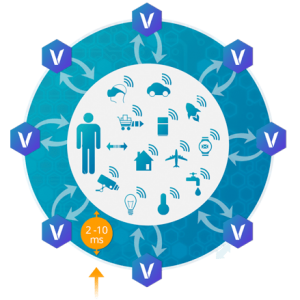Today we introduced Vapor Edge, an end-to-end platform for building out edge environments. This is a major milestone for Vapor IO, as we take a huge step forward in realizing our vision of data-driven data centers and bring to market a suite of technologies that help operators build out low-latency extensions to today’s cloud that will enable new classes of applications including virtual reality, augmented reality, autonomous driving, and high-speed industrial sensor analysis.
The Dawn of a New Cloud
The cloud as we know it is changing. For the last decade, it’s been dominated by very large, centralized or regional data centers. Everything we do—on our phones, in our browsers, in our connected cars—connects back to these large centralized data centers. But there is an emerging class of applications—including IoT, Virtual Reality, and mobile apps—where the existing model of large, centralized datacenters just won’t work. These applications need compute to be located more closely to the device or application. The round trip back to a centralized data center takes too long and the amount of data that needs to transferred is too large. We are constrained by the speed of light!
The cloud, in response, is becoming much more decentralized. Thousands of small, regional and micro-regional data centers are emerging and will be added to the cloud. The cloud is becoming a large, global fabric of compute with the capability of pushing workloads all the way out to within yards of the end consumer, whether that’s a sensor on an autonomous vehicle or an AR application on an iPhone.
Today’s cloud, which is dominated by large, centralized data centers, is simply not sufficient in this new world. Here’s why today’s cloud won’t work for emerging applications:
There are too many devices. There are more devices connected to the internet than there are people on Earth. Cisco IBSG estimates there are 25 billion devices connected to the Internet today and 50 billion in 5 years. It’s not practical for all of these devices to connect directly back to centralized data centers.
The pipes aren’t big enough. A modern Pratt & Whitney jet engine has over 5,000 sensors and generates 36 TB of data every hour in flight, which means a single twin-engine aircraft with a 12-hour flight time can produce up to 844 TB of data — that’s more data from a single plane than all of Facebook collects daily (at the end of 2014, it was estimated that Facebook accumulated around 600 TB of data per day). Even with an ultra-fast 100GB/s connection it would take nearly 6 hours to transmit all of that data to a central location.
The speed of light is too slow. It takes 75ms to 150ms to do a round trip from a device in New York to a data center in San Francisco. For some applications, this is just too slow. For example, when the frame rate of a VR or AR application falls below 75 frames-per-second (fps) people tend to get motion sickness. (75 fps requires response times below 13ms.) Autonomous vehicles need local processing that is in the 3-5ms range. For these kinds of applications, a remote datacenter will be 2-10 times too slow.
Edge Computing is the Solution
By putting compute capacity at the edge of the network, you substantially speed up interactions, remove latency and reduce network and compute load back to the centralized data centers. It’s now possible (using Vapor IO technology, for instance) to put micro-data-centers in thousands of cell towers, which puts cloud capacity at the edge of the network, near the devices they need to talk to
Edge computing solves all of the problems identified above:
It can support many more device connections in aggregate because each edge compute micro-data-center only needs to worry about devices in its vicinity
It can process vast amounts of data because each micro-data-center only needs to collect the data from the devices in its vicinity. They can process the data locally and only need to send the results to the centralized servers.
Because edge nodes are located near the devices, their response time is much faster, supporting response times in the sub 10ms range if required.
What is Vapor Edge
Vapor Edge consists of specialized software for remote operation and workload management, as well as patented hardware designs which are optimized for edge environments and manufactured by partners under license. Included are:
Vapor Chamber: Optionally, operators use Vapor Chamber designs to build out the physical environment for Vapor Edge. The Vapor Chamber is a revolutionary circular racking system for servers, designed by Vapor IO, which is licensed to manufacturers who sell and distribute the system. The Vapor Chamber is tightly integrated with Vapor Edge software, and is ideal for use in more hostile edge environments, such as in cell towers and on rooftops. It is self-contained, extremely energy efficient and well-suited for remote operation. Customers can also retrofit existing equipment into a Vapor Edge environment, with or without Vapor Chambers.
Vapor CORE: Operators use Vapor CORE software to remotely monitor and administer their Vapor Edge environments. Vapor CORE spans all of the centralized data center and edge machines, ingests hardware telemetry in real time, and provides operators with a way to remotely view and manage their edge capabilities.
Vapor Compass: Operators use Vapor Compass software to build highly-automated command-and-control policies for managing workloads in distributed edge environments. Vapor Compass makes real-time optimization decisions, including rescheduling workloads onto edge nodes or centralized data centers, based on policies, including latency and cost.
Vapor IO’s software is built atop the Open Data Center Runtime Environment (OpenDCRE), an open source protocol created by Vapor IO for monitoring and responding to data center hardware, software and environmental characteristics in hybrid and edge environments. Vapor Edge integrates with public clouds, such as Amazon Web Services and Microsoft Azure, as well as popular private clouds, such as OpenStack and VMware Vsphere, as well as with modern container-driven systems, such as Mesosphere’s DC/OS and the Cloud Native Computing Foundation’s Kubernetes.
Vapor IO has developed everything you need to build out edge networks “from mud to cloud.” We have hardware designs, including the Vapor Chamber, a ruggedized and modular infrastructure rack and housing system, suitable for harsh edge and urban (i.e., cell tower) conditions. We also have software for remote monitoring and maintenance, as well as software for monitoring and managing workloads across data centers and edge nodes in an edge environment.

Vapor Edge allows operators to construct highly-automated command-and-control policies for optimizing workloads in edge environments, evaluating key parameters including latency, cost, security and privacy, then making real-time optimization decisions, including rescheduling workloads onto different machines, onto different edge nodes or onto different centralized or regional data centers.
One of the first deployments of Vapor Edge will be with Centrepointe, a data center company located in the Czech Republic, which has entered into an agreement to purchase Vapor Edge technologies from Vapor IO and has partnered with Vapor IO to build out a 200-megawatt data center locally, called DataHub Verne. DataHub Verne will be one of the most modern, green and efficient data centers built to-date, and will provide low-latency edge capabilities to Prague, Frankfurt and the surrounding areas.
We plan additional deployments in 2017, including one that involves cell towers in a major American city. We’re excited to have you along on this journey and we’re eager to help advance the next generation of cloud.



